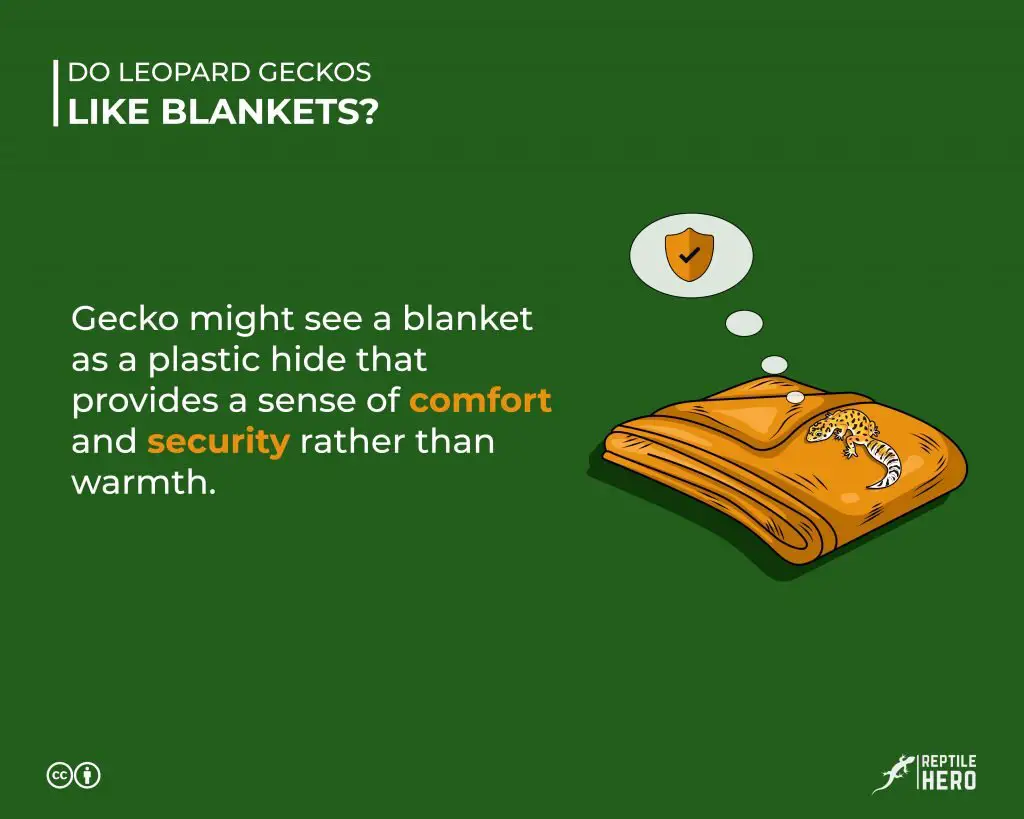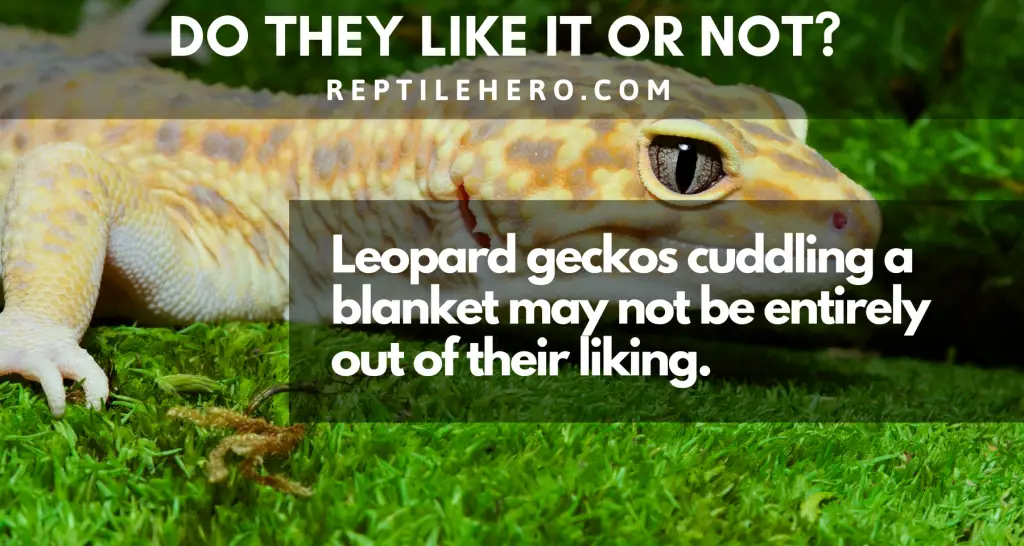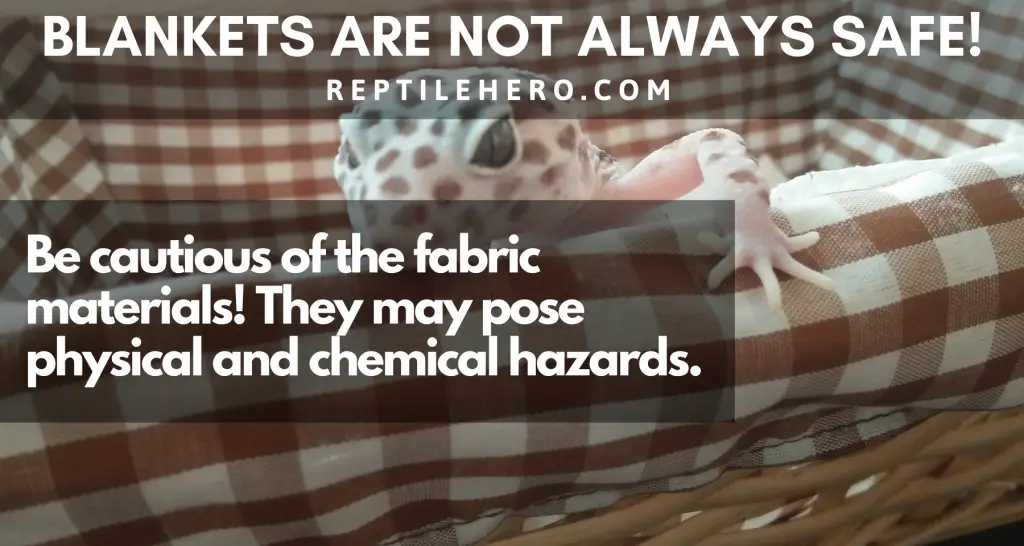Do Leopard Geckos Like Blankets? [Best Fabrics]
Have you been handling your leopard gecko for quite some time? I am pretty sure you experienced it hiding inside your hoodie. However, if you were to provide a soft blanket inside its tank, do you think your gecko would cuddle it just the same? Or would your pet favor the use of a plastic hide over it?
Leopard geckos may not necessarily like a blanket the way humans perceive it to be. Gecko might see a blanket as a plastic hide that provides a sense of comfort and security rather than warmth.
If you are like me, who has always wondered whether geckos like blankets, then just keep on reading.

What Leopard Geckos Cuddling A Blanket Mean
Unless otherwise scientifically proven or disproven, we may never truly know why leopard geckos would seem to enjoy cuddling soft blankets. However, there are three ways to look at this situation:
- Mental Aspect
- Emotional Aspect
- Physical Aspect
Mentally, What Do Geckos Think?
Research about mental aptitude in reptiles—especially in leopard geckos—has seen little progress over the years. Just like you would think, scientists have thought of these animals as “instinct machines,” completely overlooking their intelligence. However, “cold-blooded cognition” has grown a lot of interest lately.
Recent studies have shown that reptilian brains are not as primitive as we have first imagined. For instance, iguanas have exhibited learning through experience—recognizing simple causation [1]. Although the process takes a lot of your patience away, many owners have shared their success with a leash and potty training!
However, making decisions requires consciousness and self-awareness. Leopard geckos may lack both, although the idea cannot be wholly disregarded. So, since little is known about how vast their intelligence is, it is very likely that geckos may identify a soft blanket as a plastic hide thing.
Nonetheless, the gecko would use either object arbitrarily. And if you would observe your gecko prefer one over the other, a different factor may have come to play—like emotions.
Emotionally, What Do Geckos Perceive?
The amygdala, hippocampus, and limbic system are some of the various parts of our brain responsible for processing complex human emotions [2]. As a result, we are capable of feeling them the way that we do today.
Meanwhile, reptiles—including leopard geckos—have a hippocampus for different purposes: their spatial recognition in the environment and their relation to other things in the surroundings [3]. For that reason, they may have emotions in a manner that could be unconventional for us.
Predominantly, geckos display basic emotions of aggression and fear, although they have the neuroanatomy required to feel pain. So, they must feel discomfort as well [4]. However, reptile owners argue that their pets exhibit a sense of pleasure when offered food.
More often than not, the actions you notice from your gecko would stem from aggression and fear. For instance, observing your pet cuddle the soft blanket does not directly correlate to pleasure. But we cannot just dismiss the thought entirely.
“If not for pleasure, then what? Does the gecko in the video below not look happy to you?” you might ask.
The most logical explanation for this common incident is that cuddling the blanket does not induce fear and pain but provides comfort and safety.
Given the available information, a gecko would adversely react to fearful and painful stimuli—just like how we would! As a result, this would mean a negative association for it. So, you should definitely observe it scramble away from the soft blanket.
However, since you noticed the gecko stayed, the soft blanket must have provided it a sense of comfort and security instead. Not much of a “pleasure” thing; it could be more of a positive association. So, it may find the object—whether a soft blanket or a plastic hide—harmless and safe to cuddle.
Physically, What Do Geckos Feel?
Geckos are not attracted by a blanket for warmth. Just like most animals, including humans, leopard geckos associate being in an enclosed space, like enveloped in a blanket, with safety.
This also explains why in a perfect vivarium setup, having a hide (usually round with hole with easy access) is a must in any gecko tank setup.
“But does wrapping my gecko around a soft blanket not make it feel warm? It does look like my pet is comfortable with it,” you might ask.
Let us have a little science throwback. A leopard gecko is a cold-blooded animal—along with other reptiles, fish, and amphibians. Being cold-blooded, it has the following qualities [5]:
- Cannot regulate and maintain constant body temperature
- Obtains heat from the surrounding environment
So, a gecko under a blanket for an extended period does not keep it warm. If truth be told, covering it with a blanket would insulate your pet from the outside heat. Conversely, this situation would actually cool the reptile by a couple of degrees and prevent it from warming up.
To put things into another perspective, you may think of the soft blanket as a vacuum flask’s insulation. Both work similarly by preventing warming inside the bottle. This allows the cold beverage to stay cool. Thus, you should not wrap your gecko around a blanket alone for a long time, especially when it is sleeping.
“Then, what about us? Being under the sheets gives us warmth. Right? So, can I be under the blanket with my gecko,” you might add.
Together with birds and other mammals, we are warm-blooded creatures. Thus, we possess the following capabilities [5]:
- Able to maintain and regulate internal body temperature
- Obtains heat and energy from food consumption
Being a warm-blooded as you are, your body generates heat that the blanket would trap. As an effect, the confined heat would keep both you and your gecko warm. Now that you know, you should only keep your pet under the sheets when you are around.

Should You Provide A Blanket?
Does that mean you can give your gecko a blanket? Definitely! But you should never leave it alone under the sheets.
If you are the curious and creative one, you may want to utilize and explore fabric hides. What is fascinating is that you can customize them to your liking and your tank’s motif. However, you just have to be cautious about what fabrics you use.
What Fabrics Can Be Used For Geckos?
Most likely, you would encounter different types of blankets when choosing which suits your liking best. Here are seven common fabric materials to choose from:
- Acrylic
- Cotton
- Fleece
- Polyester
- Silk
- Wool
- Vellux
Natural Fabrics
Natural fabrics are woven or knitted from fibers that come from animals, minerals, and plants. Typically used as blanket materials are cotton, silk, and wool.
| Cotton | Silk | Wool |
|---|---|---|
| hypoallergenic very soft material | softest natural fabric breathable material lightweight fabric | most breathable fire-resistant itchy surface |
Synthetic Fabrics
Meanwhile, synthetic fabrics are purely man-made textiles that substitute natural fibers. Some commonly used in blankets are acrylic, fleece, polyester, and Vellux.
| Acrylic | Fleece | Polyester | Vellux |
|---|---|---|---|
| hypoallergenic machine washable does not stain | non-allergic easy to maintain lightweight | affordable durable machine washable | hypoallergenic can be washed multiple times |
Dangers of Blankets
Whether you would use a blanket for your gecko to play with or as a material on a custom-made hide, you have to be aware that it can harm your pet along the way by its physical or chemical hazards.
Physical Hazards
- May cause physical injuries due to the fabric’s nature
- May foster skin conditions like cellulitis and dermatitis
- May harbor pathogens like bacteria, fungi, parasites, viruses
Chemical Hazards
- May retain lingering scents of laundry detergents, perfumes, or any sanitizers
- May have hazardous dyes containing arsenic, cadmium, chromium, cobalt, copper, lead, mercury, and zinc
Both physical and chemical hazards can cause serious harm to your gecko, which can put its life in danger. That is why, while you can let it cuddle with a blanket or rest inside a fabric hide, it is still best for you to avoid using any of it when possible.

Takeaways
A lot is unknown of leopard geckos’ mental ability. So, they may see blankets the same as plastic hides and use both items indiscriminately.
Leopard geckos can be emotionally driven by positive and negative associations. They could be cuddling the blanket due to a positive experience or run away from a negative one.
Contrary to a popular misconception, covering leopard geckos with a blanket does not make its body warm. Actually, it could drop their body temperature due to isolation from the room’s warmth.
Seven common fabric materials can be used when making customized hides. These are acrylic, cotton, fleece, polyester, silk, wool, and Vellux.
While fabrics can be safe for leopard geckos to some extent, they can still pose dangers to the reptile. These dangers are classified as physical and chemical hazards.
Sources
- [1] http://www.anapsid.org/tamingvh.html
- [2] https://opentextbc.ca/introductiontopsychology/chapter/3-2-our-brains-control-our-thoughts-feelings-and-behavior/
- [3] https://www.ncbi.nlm.nih.gov/pmc/articles/PMC4406946/
- [4] https://onlinelibrary.wiley.com/doi/10.1002/9781118999196.ch38
- [5] https://www.open.edu/openlearn/nature-environment/introducing-mammals/content-section-6.1

![Are Christmas Trees Dangerous to Reptiles? [10 Risks & 21 Trees]](https://www.reptilehero.com/wp-content/uploads/2022/01/christmas-tree-pose-risk-reptile-cc-768x614.jpg)
![Taking Care of Geckos During Power Outages [Final Guide]](https://www.reptilehero.com/wp-content/uploads/2021/04/Gecko-Care-Power-Outage-768x614.jpg)
![3 Reasons Why Your Gecko Smells Bad [and 7 Tips]](https://www.reptilehero.com/wp-content/uploads/2021/04/G34_2-1-768x614.jpg)

![9 Woods Safe For Gecko Tanks [and 16 to Avoid]](https://www.reptilehero.com/wp-content/uploads/2021/04/Wood-Avoid-Gecko-Tank-768x614.jpg)
